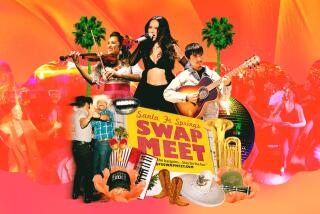Chicano rock lives
In 1998, when David Reyes and Tom Waldman first published their authoritative history of Chicano rock ânâ roll in Southern California, âLand of a Thousand Dances,â their home state was in upheaval. The aftershocks of Proposition 187(1994) were rattling California politics. Thousands of migrants pouring in from war-torn Central America were remaking the landscape of Latino L.A. And the rock en espanol movement was erupting, hinting at a potentially seismic shift in Latino cultural tectonics.
A decade later, Los Angeles has a Mexican-American mayor, Latino artists are increasingly visible in U.S. culture, and the âLatinizationâ of American life is occurring in practically every state. But one thing hasnât changed, the authors say. Most Chicano rock bands, despite their continuing creativity, remain marginal to the mainstream rock scene.
âWe still to this day donât have a model for what it means to make it, and really make it, in the Anglo market for a Chicano band,â said Waldman, 52. âWhatâs remained elusive is that huge worldwide success.â
Thatâs partly the result of marketing decisions made by record companies and the music industry, say the authors, whoâll be appearing Sunday at Skylight Books in Los Feliz. Theyâll be joined by Lysa Flores, one of several younger Chicano artists who get considerable ink in the updated edition of âLand of a Thousand Dances,â which has just been reissued by the University of New Mexico Press, with a new introduction and photos.
But the authors also believe that Chicano artists face unusual challenges in American society, where theyâre pressured to maintain a strong sense of Mexican identity but also to assimilate. As the men state in their bookâs conclusion, Chicano musicians, from Ritchie Valens to Los Lobos and beyond, have labored to incorporate Anglo-American pop music as well as Mexican and Latin influences.
âThis not only contradicts the racists,â the authors write, âbut also the radicals, who while postulating a distinct Chicano identity seem to forget that Chicanos have been intimately connected to American life for decades.â
âWeâre still not out of that restrictive definition of what a Chicano musician is, in America,â said Waldman. For many Chicano rockers, he adds, the crucial question remains: âHow do I resist the pressures both from Anglos and Chicanos to be the kind of musician they want me to be?â
The urge to venture past restrictive musical boundaries helped bring Reyes, 56, and Waldman together in the late â70s, when they worked together at Tower Records in West Covina. Reyes already was a budding music historian and archivist, amassing a vast personal collection of vinyl and vintage photographs. The storeâs clientele was a mixture of punk rockers, English-speaking suburban rockers into the likes of Journey and Cheap Trick, plus Latinos from El Monte and Pomona.
The two men discovered a mutual fascination with Valens, Chicano rockâs founding icon, as well as with seminal Chicano rock bands such as Thee Midniters and Cannibal & the Headhunters (who once toured with the Beatles), and with influential disc jockeys Art Laboe, Dick âHuggy Boyâ Hugg and others who helped popularize the East L.A. sound.
Dismayed that most conventional histories of rock ânâ roll had ignored Chicano rock, or failed to elucidate its social context, Reyes and Waldman determined to write an alternative history. They began culling material from Reyesâ personal collections and tracking down some of the old-timers for taped interviews. Many of the veteran musicians, whoâd never been solicited by writers before, were eager to share memories.
âThe word started spreading we were doing this, and that helped a lot,â said Reyes. âGreat stories. We couldnât fit âem all in the book.â
Only a few months after the bookâs original publication, the authors were approached by L.A.-based filmmaker Jon Wilkman about making a documentary about Southern California Chicano rock. The fruit of that collaboration, âThe Chicano Wave (La Onda Chicana),â will be seen as part of a four-hour PBS series, âLatin Music USA,â in October.
Despite a dearth of live-music venues in East L.A., and the authorsâ view that rock en espanolâs success has splintered an already fractured Spanish-language music market, Waldman and Reyes believe that Chicano rock can continue to flourish with artists such as Flores, the politically charged Quetzal and Ozomatli, and a number of emerging Latino bands from L.A.âs middle-class suburbs.
In preparing the bookâs new edition, Waldman said, âDavid and I looked at some of the young bands. And I think they want to rock.â
--
More to Read
Sign up for our Book Club newsletter
Get the latest news, events and more from the Los Angeles Times Book Club, and help us get L.A. reading and talking.
You may occasionally receive promotional content from the Los Angeles Times.










